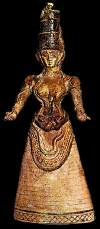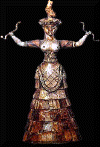
|
|
|
|
|
|
|
|
|
|
|
|
|

The Bronze Age started in the third millennium B.C. and with it brought
great advancements to the world. The tools and weapons of the day
were soon made stronger and more durable. This change allowed for
a population increase since farming and hunting became more efficient and
could support more people. Also changed were daily household items
such as the brooch (accompanying image). It is still a controversy
as to who it was that introduced the discovery of smelting bronze.
The Bronze Age, which was in full swing by the third millennium B.C., spread across Europe and Asia at roughly the same time to change everyday life. Many changes made life easier while some made life more extravagant. Warfare also made large advancements due to the invention of bronze. Who started the Bronze Age is still a bit of a controversy, some feel it started in different parts of Europe, spread from Asia, or it began at roughly the same time across the known world.
The Bronze Age was the result of a short period known as the copper age; this is because bronze is a form of copper mixed with tin. Many metal workers used a 90% copper to 10% tin ration when smelting their product (Martin, 14). The largest impact that bronze had was seen in weapons that were produced in this time period.
In fact one weapon was advanced so greatly that a new weapon came in existence due to bronze. This weapon was the dagger; every person, even the low class citizens, had a dagger in his possession during this time. However, metal workers soon found that bronze allowed them to make the blade longer, and soon the sword was being made along with daggers. At first the swords were made for ceremonial events and for display in a wealthy home. The sword soon did find its way to the battlefield, but it was not used in the manner we think of today. Swords were used as daggers but had longer blades, it took some time for men to realize that they could swing the sword and also inflict bodily harm to the enemy (Quennell, 23). Swords greatly increased the death rate of warfare and also helped men kill more food. However, daggers were not the only weapons that saw advances.
Until this time arrowheads and spearheads were
made using animal bones and stone that could be carved to form the pointed
edge needed in battle or hunting. Bronze soon took the place of these
materials for many good reasons. Stones and bone could not do this because
they were carved and not molded into form like bronze was. Copper was not
used because it lost its shape too easily and thus became ineffective for
use. Bronze however kept its shape very well and was also able to
form and hold razor shape edges (Martin, 22). The technology of bronze
made hunting and warfare much more lethal.
 Bronze also changed the face of weapons in another way that did not necessary
help man. Bronze was the first material used for daggers, swords,
and shields that could be decorated in a very extravagant way. Many
sword and dagger blades contained carvings in the bronze blade that depicted
anything from hunting and battle scenes to animals. The decoration
depended on were the blade was produced and what it was intended to be
used for (Cotterell, 126). Many swords used in battle had prints
on them that would distinguish how wealthy the man carrying the sword was.
Since wealthy men would pay for this type of work it allowed poor smiths
to rise to a rich artisan in the societyís eyes.
Bronze also changed the face of weapons in another way that did not necessary
help man. Bronze was the first material used for daggers, swords,
and shields that could be decorated in a very extravagant way. Many
sword and dagger blades contained carvings in the bronze blade that depicted
anything from hunting and battle scenes to animals. The decoration
depended on were the blade was produced and what it was intended to be
used for (Cotterell, 126). Many swords used in battle had prints
on them that would distinguish how wealthy the man carrying the sword was.
Since wealthy men would pay for this type of work it allowed poor smiths
to rise to a rich artisan in the societyís eyes.
Swords and shields were not the only items that saw artistic work being done on them, the wheel coverings of chariots were also given time to be crafted into intricate workings of art. Since smiths were working on the wheels of chariots they too saw advancements made in their production. Some believe it is this time period that the spokes of a wheel were created. Spokes of this time were not numerous in the wheel and were much larger and thicker then the thin ones of present day bike tires. These thick spokes acted as braces for the wheels of chariots and soon other objects that had wheels such as carts. The idea of spokes made the wheels very strong without as much weight necessary for them (Quennell, 161).
Many people saw the advantages of using bronze and thus it was also used in household tools such as those used for farming. In fact, bronze was the pathway for the creation of many new tools to be used by the carpenter, farmer, ship builder, gem cutter, and sculptor (Cotterell, 127). One of the tools that saw the most advancement was the ax. The ax played a very large role in everyday life, so large that the Minoan people knew they owed their civilization to the bronze ax. Many times a picture of an ax can be seen in Minoan artifacts, this shows that the Minoans understood how important it was to the life they had created for themselves (Cotterell 126).
The ax saw great changes with the discovery of bronze. The ax was made using bronze as the head and wood as the handle, the two were still fashioned together the same way as in the Stone Age. This created problems because the wood could not stand the impact of the bronze head and would often split. The first big change seen in the ax was due to this problem, a new mold that created a ring in the ax head allowed the wooden handle to be pushed through the hole. This new model could withstand the blows because the bronze ring took the impact and not the wood.
Another advancement that the ax saw was the creation of the double bladed ax. This increased the efficiency of the ax because now the back swing could also be used in the process of taking a tree down. The edge of the ax was also much stronger and sharper than the stone or copper counterparts. These advancements allowed people to clear land faster and build houses and other structures quicker than before. This allowed for an easier life and created more free time for people to explore other things during their lifetime.
The ax was not the only tool that helped people lead an easier life. The plow also was changed to make life a bit smoother. Although the frame was still made of wood the blade could now be made of bronze, which keeps its shape and razor edge much better than any other material of the day. This allowed farming to be done much quicker and more effectively than before. This also allowed people to increase food production and soon surpluses of food were seen in some villages. Other tools the farmer incorporated bronze into were hoes, sickles, and borers. These too made the job of farming easier and more efficient.
There are some items that we do not use today or do use but not a lot that saw advancement due to bronze. The first is the safety pin, although it was probably not called that during the Bronze Age. It had a shape that was crude by todayís production. However, its purpose was still met and allowed for garments to be held up and together using it. The brooch was used mostly to hold clothes up and together. This item consisted of a ring where the fabric was pulled through and a pin was inserted so that the brooch and the fabric were held together and thus kept the clothes in position (Quennell, 154). Brooches were worn on one of the two shoulders. Bronze brooches also allowed for people to have patterns etched into the bronze thus increasing their value and allowing for social classes to be seen by the type of brooch worn (Quennell, 154). This occurred with many other household items such as mirrors, combs, and pottery, advancements were not made in many of them but artisans soon began to work art onto the items.
So who was it that started this Bronze Age, well that is the tricky part, many theories and ideas exist and no one knows for sure who did smelt bronze first. Some feel that bronze came from the near east and spread to Europe through Gaul and Italy and thus through the rest of Europe (Quennell, 149). Another idea sees the Bronze Age being born in Asia and Europe at the same time independently, because evidence has been found that shows bronze existed in both places. This would not be possible some feel, because it would take time for the idea to diffuse from one place to the other (Martin, 14). This question will go on unanswered until more research is done and evidence is collected that supports one of the many theories that exists.
The Bronze Age, which ended in roughly in the first millennium B.C., saw the idea of iron smelting coming to light. Bronze was soon replaced by iron because it was strong and easier to work with than bronze. However, the Bronze Age has not been forgotten because of all the great changes that it created some very easily seen and others hidden in shadows. For example, we know that farming tools were made better, in fact so well that food supplies increased dramatically. This allowed for a large population increase because now more people could be provided for since farming was better. It is a good thing that carpenters tools were advanced because with more people alive houses needed to be made quicker, something possible due to bronze. Also ship builders used the inventions of bronze, which allowed for better boats, which allowed for more extensive trading to occur across the seas of the world. The Bronze Age made life better for everyone.
The Bronze Age made life easier for people even though it soon became one of the metals that was used less extensively. Bronze was the first metal that was worked with by many people; copper was not since it was not as durable. Bronze started the science of working with metal. This gave people the idea to find better materials, such as iron, to use with their tools as the materials advanced so did the world because it made life easier for them. Bronze is the metal that started it all.
Cotterell, Martin. The Minoan World. New York: Charles Scribnerís Sons, 1997.
Martin, Thomas R. Ancient Greece. New Haven: Yale University Press, 1996
Quennell, M. Everyday Life in Prehistoric Times. New York: G.P. Putmanís Sons, 1959.
Schuchhardt, Carl. Schliemannís Discoveries of the Ancient World. New York: Avenel Books, 1979.
Wood, Michael. In Search of the Trojan War. New York: Facts on File Publications, 1985
Site Created by: Benjamin Walczak
BenjaminGWalczak@hotmail.com